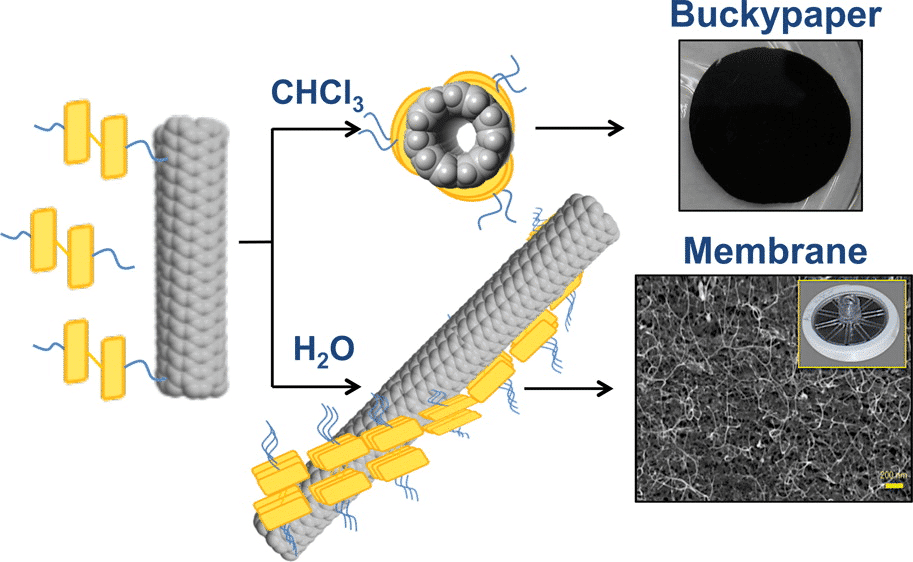
Dispersing Perylene Diimide/SWCNT Hybrids: Structural Insights at the Molecular Level and Fabricating Advanced Materials
2Department of Chemical Research Support, Weizmann Institute of Science, Rehovot
3Department of Chemistry and Pharmacy & Interdisciplinary Center for Molecular Materials, Friedrich-Alexander-Universität Erlangen-Nürnberg, Erlangen
The unique properties of carbon nanotubes (CNT) are advantageous for emerging applications. Yet, the CNT insolubility hampers their potential. Approaches based on covalent and noncovalent methodologies have been tested to realize stable dispersions of CNTs. Noncovalent approaches are of particular interest as they preserve the CNT’s structures and properties. We report on hybrids, in which perylene diimide (PDI) amphiphiles are noncovalently immobilized onto single wall carbon nanotubes (SWCNT).[1]
The resulting hybrids were dispersed and exfoliated both in water (Figure 1) and organic solvents in the presence of two different PDI derivatives, PP2b and PP3a. The dispersions were investigated using cryogenic transmission electron microscopy, providing unique structural insights into the exfoliation. A helical arrangement of PP2b assemblies on SWCNTs dominates in aqueous dispersions, while a single layer of PP2b and PP3a was found on SWCNTs in organic dispersions. Spectroscopic probing of the dispersions revealed appreciable charge redistribution in the ground state, and an efficient electron transfer from SWCNTs to PDIs in the excited state. We also fabricated hybrid materials from the PP2b/SWCNT dispersions. A supramolecular membrane was prepared from aqueous dispersions and used for size-selective separation of gold nanoparticles. Hybrid buckypaper films were prepared from the organic dispersions. In the latter, high conductivity results from enhanced electronic communication and favorable morphology within the hybrid material. Our findings shed light onto SWCNT/dispersant molecular interactions, and introduce a versatile approach toward universal solution processing of SWCNT based materials.
[1] Y. Tsarfati, V. Strauss, S. Kuhri, E. Krieg, H. Weissman, E. Shimoni, J. Baram, D. M. Guldi and B. Rybtchinski, J. Am. Chem. Soc., 137, 7429 (2015).

Fig. 1: Material fabrication from hybrids of PP2b/SWCNT dispersions in aqueous and organic media
This work was supported by the Minerva Foundation, Gerhardt M.J. Schmidt Minerva Center of Supramolecular Architectures, and the Helen and Martin Kimmel Center for Molecular Design. The work at Friedrich-Alexander-Universität Erlangen-Nürnberg was also supported by the Deutsche Forschungsgemeinschaft. The TEM studies were conducted at the Irving and Cherna Moskowitz Center for Nano and Bio-Nano Imaging (Weizmann Institute).

Powered by Eventact EMS